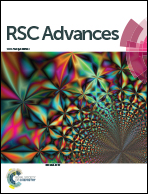Outstanding dielectric constant and piezoelectric coefficient in electrospun nanofiber mats of PVDF containing silver decorated multiwall carbon nanotubes: assessing through piezoresponse force microscopy
Abstract
In order to enhance the piezoelectric β-phase, PVDF was electrospun from DMF solution. The enhanced β-phase was discerned by comparing the electrospun fibers against the melt mixed samples. While both the processes resulted in phase transformation of α- to electroactive β-polymorph in PVDF, the fraction of β-phase was strongly dependent on the adopted process. Two different nanoscopic particles: carboxyl functionalized multiwall carbon nanotubes (CNTs) and silver (Ag) decorated CNTs were used to further enhance the piezoelectric coefficient in the electrospun fibers. Fourier transform infrared spectroscopy (FTIR) and wide-angle X-ray diffraction (XRD) supports the development of piezoelectric β-phase in PVDF. It was concluded that electrospinning was the best technique for inducing the β-polymorph in PVDF. This was attributed to the high voltage electrostatic field that generates extensional forces on the polymer chains that aligns the dipoles in one direction. The ferroelectric and piezoelectric measurement on electrospun fibers were studied using piezo-response force microscope (PFM). The Ag–CNTs filled PVDF electrospun fibers showed the highest piezoelectric coefficient (d33 = 54 pm V−1) in contrast to PVDF/CNT fibers (35 pm V−1) and neat PVDF (30 pm V−1). This study demonstrates that the piezoelectric coefficient can be enhanced significantly by electrospinning PVDF containing Ag decorated nanoparticles.



 Please wait while we load your content...
Please wait while we load your content...